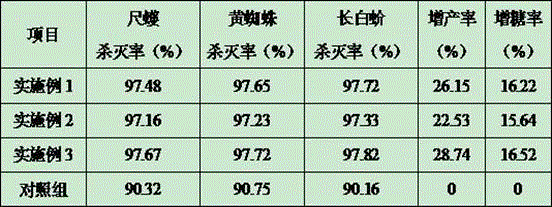Novel botanical insecticide
A new type of plant and pesticide technology, applied in the directions of plant growth regulators, plant growth regulators, biocides, etc., can solve the problems of pest resistance to polluting the environment and the single function of insecticides, and is conducive to popularization and application. , good application effect, low cost effect
- Summary
- Abstract
- Description
- Claims
- Application Information
AI Technical Summary
Problems solved by technology
Method used
Image
Examples
preparation example Construction
[0061] The preparation method of described novel botanical insecticide comprises the following steps:
[0062] S1: Mix and pulverize Chinese prickly ash, onion, garlic, wasabi, wormwood, neem, bitter bark vine, ailanthus, lettuce, mint, and castor to obtain mixture I. Add mixture I to ethanol, and the ratio of solid to liquid is 1: 14-16, the ultrasonic power is 200-300W, the ethanol concentration is 65%-80%, and the extraction temperature is 66-72°C, extract the medicinal solution for 18-24min to prepare the medicinal solution;
[0063] S2: passing the liquid medicine prepared in step S1 through a 3000-5000 mesh sieve to obtain a filtrate;
[0064] S3: adding potassium salt, phosphorus salt, nitrogen salt, calcium salt, magnesium salt, iodine salt, boron salt, molybdenum salt, zinc salt, manganese salt, copper salt, iron salt, vitamin, amino acid, Indolebutyric acid, gibberellin, 6-benzyl adenine, naphthaleneacetic acid, agar, kinetin, polyvinylpyrrolidone, sodium methylene ...
Embodiment 1
[0069] A novel botanical insecticide, in parts by weight, comprising the following raw materials: 90 parts of Chinese prickly ash, 90 parts of onion, 75 parts of garlic, 75 parts of wasabi, 65 parts of wormwood, 65 parts of neem, 55 parts of bitter bark vine, 55 parts of Ailanthus sinensis, 50 parts of lettuce, 50 parts of mint, 40 parts of castor, 2.5 parts of potassium salt, 2 parts of phosphorus salt, 1.5 parts of nitrogen salt, 0.8 part of calcium salt, 0.8 part of magnesium salt, 0.3 part of iodine salt, 0.3 part of boron salt 0.3 parts of molybdenum salts, 0.3 parts of zinc salts, 0.3 parts of manganese salts, 0.3 parts of copper salts, 0.3 parts of iron salts, 0.3 parts of vitamins, 0.2 parts of amino acids, 0.08 parts of indole butyric acid, 0.08 parts of gibberellins, 6- 0.07 parts of benzyl adenine, 0.05 parts of naphthaleneacetic acid, 0.2 parts of agar, 0.05 parts of kinetin, 1.6 parts of polyvinylpyrrolidone, 1.2 parts of sodium methylene bis-naphthalene sulfonate,...
Embodiment 2
[0098] A novel botanical insecticide, in parts by weight, comprising the following raw materials: 84 parts of Chinese prickly ash, 84 parts of onion, 62 parts of garlic, 60 parts of wasabi, 50 parts of wormwood, 50 parts of neem, 40 parts of bitter bark vine, 40 parts of Ailanthus sinensis, 35 parts of lettuce, 35 parts of mint, 30 parts of castor, 2 parts of potassium salt, 1 part of phosphorus salt, 1 part of nitrogen salt, 0.6 part of calcium salt, 0.6 part of magnesium salt, 0.2 part of iodine salt, 0.2 part of boron salt 0.2 parts of molybdenum salts, 0.2 parts of zinc salts, 0.2 parts of manganese salts, 0.2 parts of copper salts, 0.2 parts of iron salts, 0.2 parts of vitamins, 0.2 parts of amino acids, 0.06 parts of indole butyric acid, 0.06 parts of gibberellin, 6- 0.06 parts of benzyl adenine, 0.04 parts of naphthaleneacetic acid, 0.1 parts of agar, 0.04 parts of kinetin, 0.8 parts of polyvinylpyrrolidone, 0.6 parts of sodium methylene bis-naphthalene sulfonate, 1 part...
PUM
 Login to View More
Login to View More Abstract
Description
Claims
Application Information
 Login to View More
Login to View More - Generate Ideas
- Intellectual Property
- Life Sciences
- Materials
- Tech Scout
- Unparalleled Data Quality
- Higher Quality Content
- 60% Fewer Hallucinations
Browse by: Latest US Patents, China's latest patents, Technical Efficacy Thesaurus, Application Domain, Technology Topic, Popular Technical Reports.
© 2025 PatSnap. All rights reserved.Legal|Privacy policy|Modern Slavery Act Transparency Statement|Sitemap|About US| Contact US: help@patsnap.com

